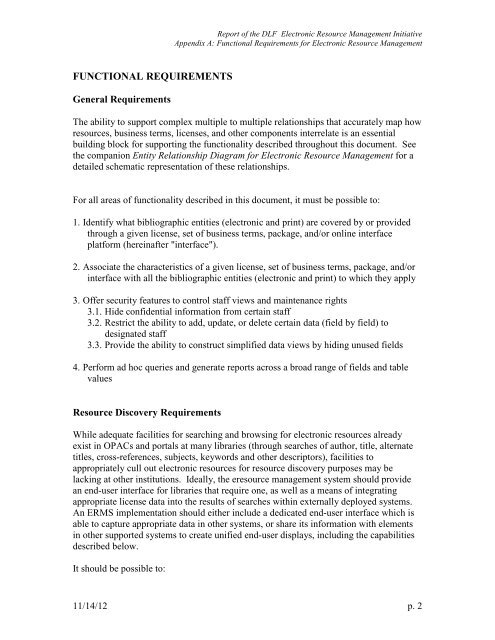Report of the DLF Electronic Resource Management Initiative ...
Report of the DLF Electronic Resource Management Initiative ...
Report of the DLF Electronic Resource Management Initiative ...
Create successful ePaper yourself
Turn your PDF publications into a flip-book with our unique Google optimized e-Paper software.
FUNCTIONAL REQUIREMENTS<br />
General Requirements<br />
<strong>Report</strong> <strong>of</strong> <strong>the</strong> <strong>DLF</strong> <strong>Electronic</strong> <strong>Resource</strong> <strong>Management</strong> <strong>Initiative</strong><br />
Appendix A: Functional Requirements for <strong>Electronic</strong> <strong>Resource</strong> <strong>Management</strong><br />
The ability to support complex multiple to multiple relationships that accurately map how<br />
resources, business terms, licenses, and o<strong>the</strong>r components interrelate is an essential<br />
building block for supporting <strong>the</strong> functionality described throughout this document. See<br />
<strong>the</strong> companion Entity Relationship Diagram for <strong>Electronic</strong> <strong>Resource</strong> <strong>Management</strong> for a<br />
detailed schematic representation <strong>of</strong> <strong>the</strong>se relationships.<br />
For all areas <strong>of</strong> functionality described in this document, it must be possible to:<br />
1. Identify what bibliographic entities (electronic and print) are covered by or provided<br />
through a given license, set <strong>of</strong> business terms, package, and/or online interface<br />
platform (hereinafter "interface").<br />
2. Associate <strong>the</strong> characteristics <strong>of</strong> a given license, set <strong>of</strong> business terms, package, and/or<br />
interface with all <strong>the</strong> bibliographic entities (electronic and print) to which <strong>the</strong>y apply<br />
3. Offer security features to control staff views and maintenance rights<br />
3.1. Hide confidential information from certain staff<br />
3.2. Restrict <strong>the</strong> ability to add, update, or delete certain data (field by field) to<br />
designated staff<br />
3.3. Provide <strong>the</strong> ability to construct simplified data views by hiding unused fields<br />
4. Perform ad hoc queries and generate reports across a broad range <strong>of</strong> fields and table<br />
values<br />
<strong>Resource</strong> Discovery Requirements<br />
While adequate facilities for searching and browsing for electronic resources already<br />
exist in OPACs and portals at many libraries (through searches <strong>of</strong> author, title, alternate<br />
titles, cross-references, subjects, keywords and o<strong>the</strong>r descriptors), facilities to<br />
appropriately cull out electronic resources for resource discovery purposes may be<br />
lacking at o<strong>the</strong>r institutions. Ideally, <strong>the</strong> eresource management system should provide<br />
an end-user interface for libraries that require one, as well as a means <strong>of</strong> integrating<br />
appropriate license data into <strong>the</strong> results <strong>of</strong> searches within externally deployed systems.<br />
An ERMS implementation should ei<strong>the</strong>r include a dedicated end-user interface which is<br />
able to capture appropriate data in o<strong>the</strong>r systems, or share its information with elements<br />
in o<strong>the</strong>r supported systems to create unified end-user displays, including <strong>the</strong> capabilities<br />
described below.<br />
It should be possible to:<br />
11/14/12 p. 2
















